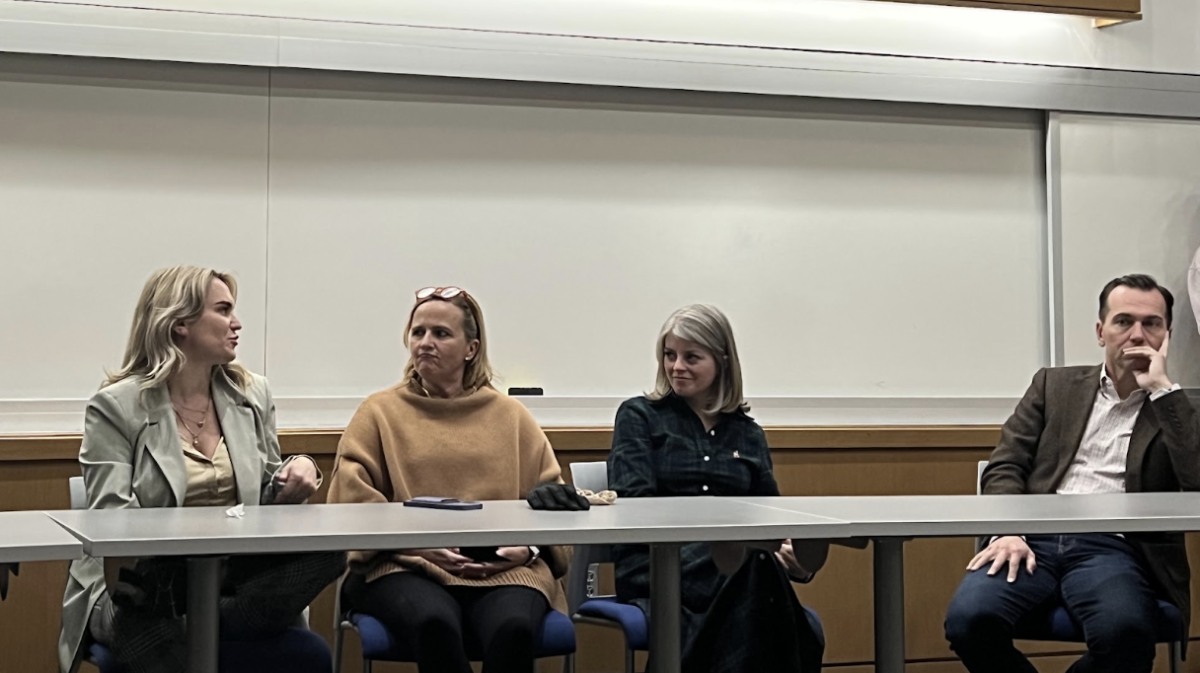Arianna Huffington is a smart woman. Say what you will about the Huffington Post: it’s still popular, still profitable, and still provides news. With this in mind, imagine my surprise when she spat this out on her 10/7 Sunday Roundup:
“remember that at the present rate of 114,000 jobs added a month, it would take over a decade to reach full employment.” [1]
With the accepted economic definitions of full employment (see below), this is an ambiguous statement at best. It got me thinking though: if Arianna Huffington can publish mistakes that beginning macroeconomic students shouldn’t make, are there other flaws in the way we talk about economics?
In this column, I’ve made a lot of assumptions about background information. However, as the column turns towards to debate analysis, it’s time for a brief economic glossary on relevant terms.
Unemployment
As per the Bureau of Labor Statistics Glossary [2]:
Someone who is unemployed is ready and able to work, does not have a job, and has looked for work in the past four weeks. The labor force is the sum of the employed and the unemployed. The labor force does not include discouraged workers, who have looked for work in the past year but have given up their searches. Related is the labor force participation rate, the percentage of citizens over 16 and not in prison who could (theoretically) work.
Beyond the basics, there are different types of unemployment. Cyclical unemployment is generally considered most important, and it is unemployment due to where the economy is on the business cycle.
Arianna Huffington’s full employment is a pipe dream (alright, this definition isn’t in the glossary). The way she used the term, everyone in the labor force would be employed at full employment. Using her numbers, do a simple calculation: 12.1 million (the current unemployed) minus the quantity 114000 multiplied by 120 (the number of months in a decade). This actually yields a negative number, and isn’t close to the numbers used by actual economists. While it sounds ideal to have 0% unemployment, it doesn’t make sense in the real world. Most economists accept that some unemployment is necessary to keep up with inflation [3]. For this reason, the monetarist economists use the NAIRU (Non-Accelerating Inflation Rate of Unemployment) as a measure[4].
The NAIRU isn’t likely to be discussed by pundits or politicians in the near future. Likely, when someone says “full employment,” he or she means natural unemployment. The natural unemployment rate is theoretical, but represents the percent of unemployment that a country can maintain in the long run [5]. The actual unemployment rate deviates from the natural unemployment rate—for instance, a recession should cause the actual unemployment rate to increase. In an inflationary gap, an economy can achieve above full employment. However, this isn’t maintainable over a long period of time, and the economy will return to around the natural unemployment rate.
Debt vs. Deficit
As per the Treasury Direct, run by the US Treasury [6]:
A deficit is the difference between government spending and government revenues in one year. You can think of a deficit of a negative surplus. The debt is the accumulation of deficits over time. It is possible to run a surplus one year, but still have government debt. Likewise, you could hypothetically run a deficit for a few years, and still not have any government debt if the government had enough savings.
Recessions
As far as politicians go, economists are splitting hairs on this issue. Technically, there is a difference between a recession and a recessionary gap.
A recession is the contraction of an economy. In the US, the Nation Bureau of Economic Research (NBER) marks the start and end of recessions. The UK has a more straightforward definition: a recession is two quarters of negative growth. The two quarter rule is general, but captures the gist of defining a complicated phenomenon such as a recession [7].
A recessionary gap is the difference between actual GDP and the potential GDP (a hypothetical number, typically determined by long run analysis) [8]. An economy could have stopped shrinking and started growing, but still be producing less than it could. This economy would still be in a recessionary gap as it recovers. However, if there is continued growth in the economy, it may not be in a recession.
Bonus Time
I’ve mentioned them before, and I’ll mention them again: Keynes, Hayek/Austrians, and monetarists. If and when the time comes, I will explain the different theories. In the meantime, if you’ve made it this far through the glossary and you’re not opposed to rap battles, this particular song has an Austrian tilt but captures the basic differences between the Keynesian and Austrian schools.
[1] http://www.huffingtonpost.com/arianna-huffington/sunday-roundup_250_b_1945470.html#comments
[2] http://www.bls.gov/bls/glossary.htm
[3] http://en.wikipedia.org/wiki/Full_employment
[4] http://en.wikipedia.org/wiki/NAIRU
[5] http://en.wikipedia.org/wiki/Natural_rate_of_unemployment
[6] http://www.treasurydirect.gov/news/pressroom/pressroom_bpd08052004.htm
[7] http://en.wikipedia.org/wiki/Recession
[8] http://en.wikipedia.org/wiki/Recessionary_gap
Image from http://raymondpronk.wordpress.com/2012/05/17/richard-church-us-constitution-videos/.
Arianna Huffington is a smart woman. Say what you will about the Huffington Post: it’s still popular, still profitable, and still provides news. With this in mind, imagine my surprise when she spat this out on her 10/7 Sunday Roundup:
“remember that at the present rate of 114,000 jobs added a month, it would take over a decade to reach full employment.” [1]
With the accepted economic definitions of full employment (see below), this is an ambiguous statement at best. It got me thinking though: if Arianna Huffington can publish mistakes that beginning macroeconomic students shouldn’t make, are there other flaws in the way we talk about economics?
In this column, I’ve made a lot of assumptions about background information. However, as the column turns towards to debate analysis, it’s time for a brief economic glossary on relevant terms.
Unemployment
As per the Bureau of Labor Statistics Glossary [2]:
Someone who is unemployed is ready and able to work, does not have a job, and has looked for work in the past four weeks. The labor force is the sum of the employed and the unemployed. The labor force does not include discouraged workers, who have looked for work in the past year but have given up their searches. Related is the labor force participation rate, the percentage of citizens over 16 and not in prison who could (theoretically) work.
Beyond the basics, there are different types of unemployment. Cyclical unemployment is generally considered most important, and it is unemployment due to where the economy is on the business cycle.
Arianna Huffington’s full employmentis a pipe dream (alright, this definition isn’t in the glossary). The way she used the term, everyone in the labor force would be employed at full employment. Using her numbers, do a simple calculation: 12.1 million (the current unemployed) minus the quantity 114000 multiplied by 120 (the number of months in a decade). This actually yields a negative number, and isn’t close to the numbers used by actual economists. While it sounds ideal to have 0% unemployment, it doesn’t make sense in the real world. Most economists accept that some unemployment is necessary to keep up with inflation [3]. For this reason, the monetarist economists use the NAIRU (Non-Accelerating Inflation Rate of Unemployment) as a measure[4].
The NAIRU isn’t likely to be discussed by pundits or politicians in the near future. Likely, when someone says “full employment,” he or she means natural unemployment. The natural unemployment rate is theoretical, but represents the percent of unemployment that a country can maintain in the long run [5]. The actual unemployment rate deviates from the natural unemployment rate—for instance, a recession should cause the actual unemployment rate to increase. In an inflationary gap, an economy can achieve above full employment. However, this isn’t maintainable over a long period of time, and the economy will return to around the natural unemployment rate.
Debt vs. Deficit
As per the Treasury Direct, run by the US Treasury [6]:
A deficit is the difference between government spending and government revenues in one year. You can think of a deficit of a negative surplus. The debt is the accumulation of deficits over time. It is possible to run a surplus one year, but still have government debt. Likewise, you could hypothetically run a deficit for a few years, and still not have any government debt if the government had enough savings.
Recessions
As far as politicians go, economists are splitting hairs on this issue. Technically, there is a difference between a recession and a recessionary gap.
A recession is the contraction of an economy. In the US, the Nation Bureau of Economic Research (NBER) marks the start and end of recessions. The UK has a more straightforward definition: a recession is two quarters of negative growth. The two quarter rule is general, but captures the gist of defining a complicated phenomenon such as a recession [7].
A recessionary gap is the difference between actual GDP and the potential GDP (a hypothetical number, typically determined by long run analysis) [8]. An economy could have stopped shrinking and started growing, but still be producing less than it could. This economy would still be in a recessionary gap as it recovers. However, if there is continued growth in the economy, it may not be in a recession.
Bonus Time
I’ve mentioned them before, and I’ll mention them again: Keynes, Hayek/Austrians, and monetarists. If and when the time comes, I will explain the different theories. In the meantime, if you’ve made it this far through the glossary and you’re not opposed to rap battles, this particular song has an Austrian tilt but captures the basic differences between the Keynesian and Austrian schools.
[1] http://www.huffingtonpost.com/arianna-huffington/sunday-roundup_250_b_1945470.html#comments
[2] http://www.bls.gov/bls/glossary.htm
[3] http://en.wikipedia.org/wiki/Full_employment
[4] http://en.wikipedia.org/wiki/NAIRU
[5] http://en.wikipedia.org/wiki/Natural_rate_of_unemployment
[6] http://www.treasurydirect.gov/news/pressroom/pressroom_bpd08052004.htm
[7] http://en.wikipedia.org/wiki/Recession
[8] http://en.wikipedia.org/wiki/Recessionary_gap











